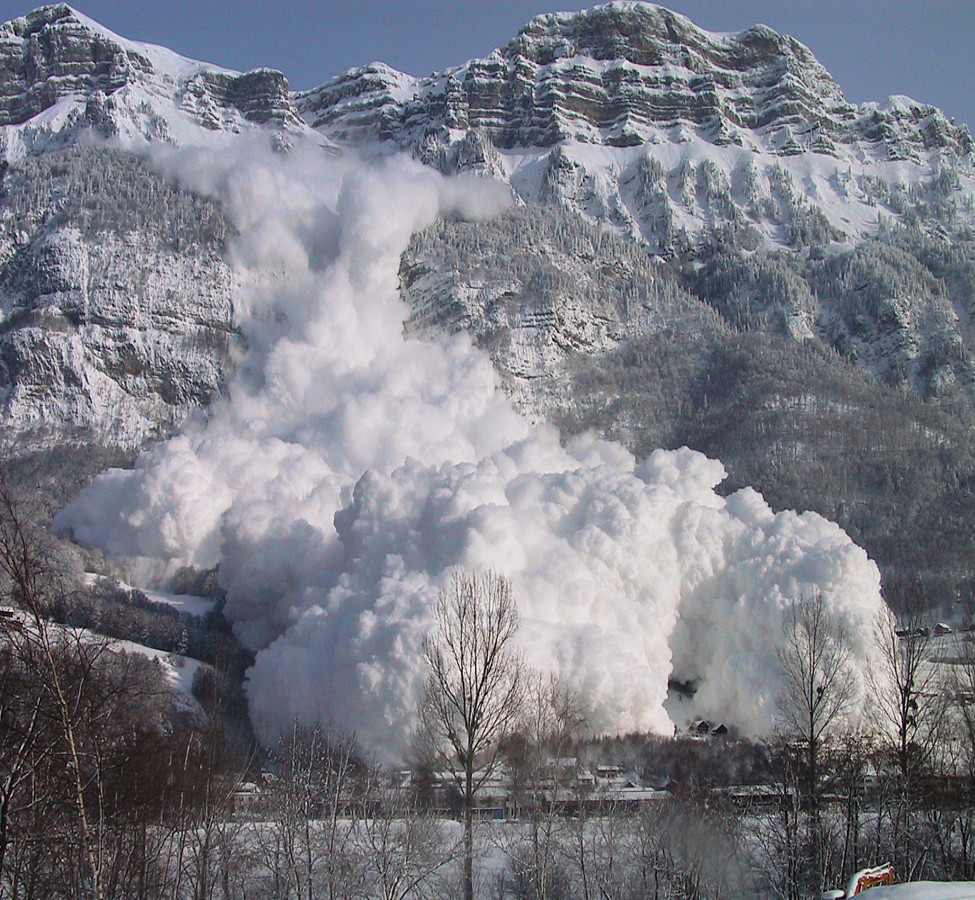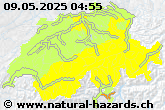Historical events
28th December 1898
Disastrous debris flows in Airolo (Ticino)
In Airolo, several debris flows, caused by severe thunderstorms, destroyed 10 houses, 15 barns as well as 30 hectares forest and land; three people were buried.
February/March 1888
Avalanches in the Alps
In the Canton of Berne, the Grisons, Saint Gall, Ticino, Uri and Valais a grand total of 1,094 (!!!) avalanches "causing serious damage" were being counted – within only two months! Result: 49 people and 700 head of livestock died, 850 buildings and 1325 hectares of forest were destroyed.
5th July 1887
Sub-aquatic slide in Zug
In this so called "suburban catastrophe" two dozens of houses sank in the lake. Some 43 other buildings were so badly damaged that they were to be torn down later on. This disaster cost 11 people their lives.
11. September 1881
Debris avalanche near Elm (Glarus)
About 10 million m3 of rock fell down into valley as a consequence of severe exploitation of slate and incessant rainfall. The masses destroyed 83 buildings, 4 bridges, 90 hectares of arable land and killed 115 people.
1857
Large-scale landslide in Campo-Valle Maggia/Ticino
A slide mass of more than 100 million m3 destroyed 10 houses and several barns.
11th - 13th December 1808
Avalanches in the Alps
Several snow avalanches killed 42 people in eastern Bernese Oberland. In the Grisons 24 people, 355 head of livestock, 9 houses and 81 barns were buried under the snow masses.
2nd September 1806
Debris avalanche of Goldau (Schwyz)
After two rather wet years, 1804 and 1805, as well as heavy rainfall in July and August 1806, between 35 and 40 million m3 of rock slid off the Rossberg on a marl layer. The villages Goldau, Roethen and Busingen were buried underneath those masses, a tidal wave in the Lake Lauerz devastated the village Lauerz. A total of 953 people, 395 head of livestock, 183 households, 126 occupied houses, 85 barns and other buildings were being wiped out. This was the worst debris avalanche in historical times.
July 1778
Flood disaster in Kuesnacht near Zurich
The brook of the village Kuesnacht raged with some 6 metres height through the village; 63 people died, 15 houses and several other buildings were destroyed, 8 bridges were carried away by the water.
June 1770
Rock fall in Praettigau (Grisons)
The village Monbiel near Klosters was badly hit by a rock fall. "...13 houses have been destroyed and 17 people lost their lives..." Cause: incessant wetness, heavy rainfall and foolish deforesting.
9th December 1755; approx. 1.30 pm
Earthquake in Brig (Valais)
Maximum intensity VIII. Damage particularly in Brig, Naters and Glis, where several houses collapsed. Almost all chimneys collapsed in Brig; a part of the vault of the Jesuit Church caved in; not one single house remained whole. In Naters the vault of the Parish Church collapsed. In Glis a huge part of the church tower fell onto the church vault, which collapsed and destroyed the altar.
6th – 7th August 1748
Flooding in the region of Basle and Aargau
In consequence of "dreadful cloudbursts" Magden AG was destroyed: "...44 people, 140 head of livestock, 14 houses and 17 barns fell victims to the water...". In Rheinfelden 32 people lost their lives.
28 December 1720
Storm in Schaffhausen
The storm was so severe that it caused an approximately 40 metre-long stretch of the western flank of the Munot fortification in the canton of Schaffhausen to collapse. The wall was around one metre thick and eight metres high. The section of wall that collapsed was rebuilt in 1721.
February 1720
Avalanche in Obergesteln (Valais)
Between 50 and 90 people were killed, as well as some 400 head of livestock. About 120 buildings were destroyed.
July 1629
Destruction of Alt-Giswil (Obwalden)
Landslides damed the "Giswiler Laui". On 13th July the collapse of the landslide dam occurred: the village Alt-Giswil (Obwalden) was buried under some 40 metres of debris.
18th September 1601
Earthquake in central Switzerland
Maximum intensity VIII. The epicentre was in the canton of Unterwalden. Several houses were destroyed completely. Landslides and debris avalanches were the consequences, such as at Hahnen near Engelberg. A landslide in Stans even carried a chapel away. Rock masses falling into Lake Lucerne set off a tidal wave (or intensify an already existing tidal wave).
25th May 1595
Flash-flood in the valley of Bagnes (Valais)
A huge ice avalanche from the Giétroz glacier damed the Drance de Bagnes to a lake. When the ice dam melted, a sudden collapse was followed by a torrent-like emptying of that lake. 140 people drowned, more than 500 buildings was destroyed; the whole valley of Bagnes down to Martigny was being devastated.
29th and 30th May 1515
The Biasca flood wave
The rockslide from Monte Crenone, which blocked the river Brenno in teh Blenio Valley and caused it to form a lake, occured on 30 September 1512. Three years later, an outburst of teh landslide dam caused the torrent-like emptying of the "lake". The flood wave wreaked destruction downstream in the Biasca valley as far as Lake Maggiore, destroyed part of the Murata (defence wall) of Bellinzona and swept away the new stone bridge over the river Ticino. 500 people were killed.
18th October 1356; approx. 10 pm
Earthquake in Basle
Maximum intensity equals or bigger than IX. In an area of about 30 kilometres almost all churches, castles and fortresses was destroyed. After the earthquake, a fire raged in the city for 8 days; the city, mostly consisting of wooden houses, burnt down almost completely within the city walls. According to several sources, the number of victims differed from 100 to 2,000. In Berne, the cathedral was damaged severely. In Jura Mountains apparently fifty debris avalanches happened. This is the strongest known earthquake north of the Alps in that millennium.
Approximately 10'000 years ago
Debris avalanche in Flims (Grisons)
On an inclined geological layer of a volume of about 13 km3 of rock (800 m long, 3 km wide) slid into the valley. The rock masses spread on an expanse of 51 km². Today, about 9 km³ of the original rock masses are still there.



